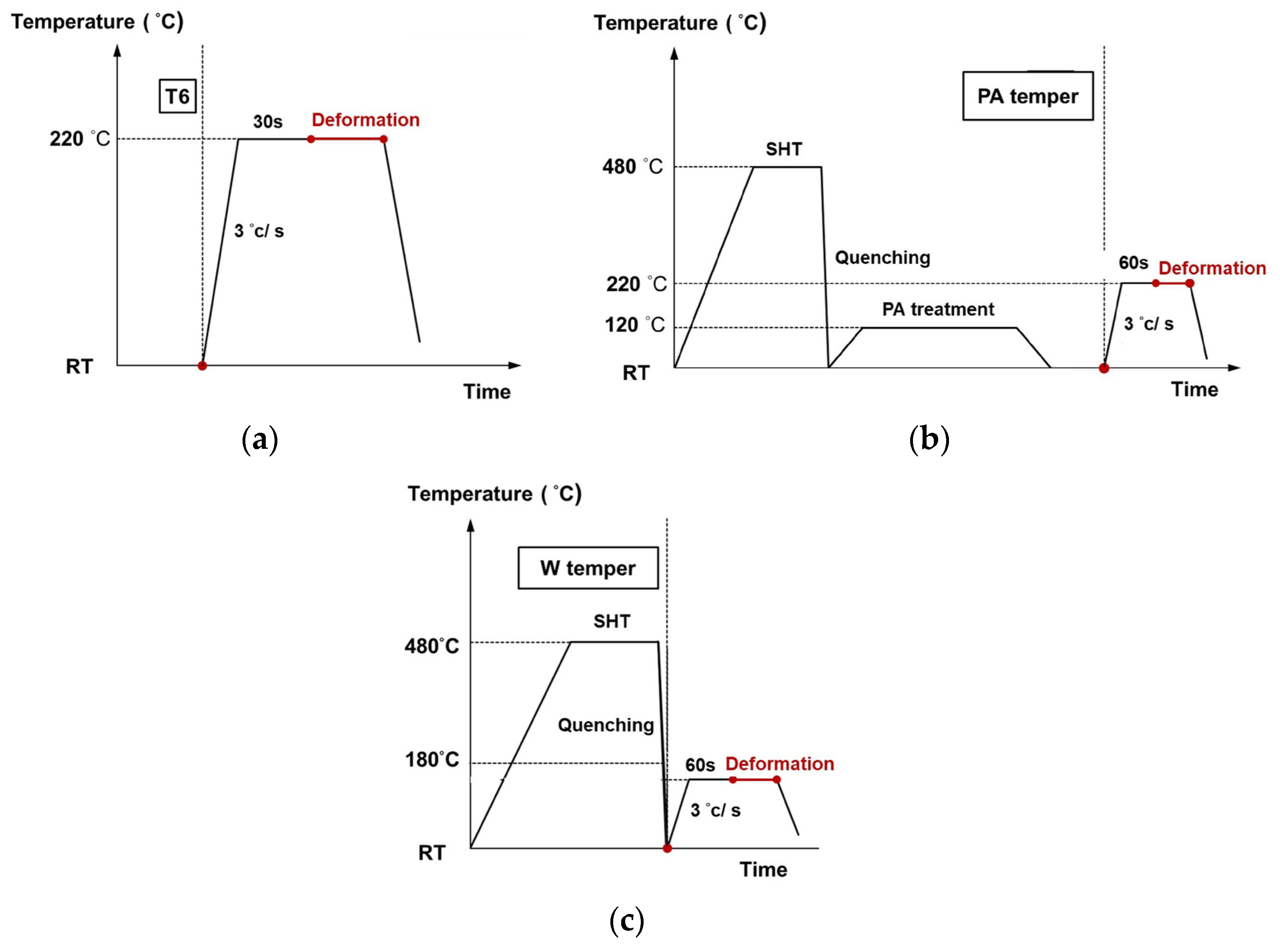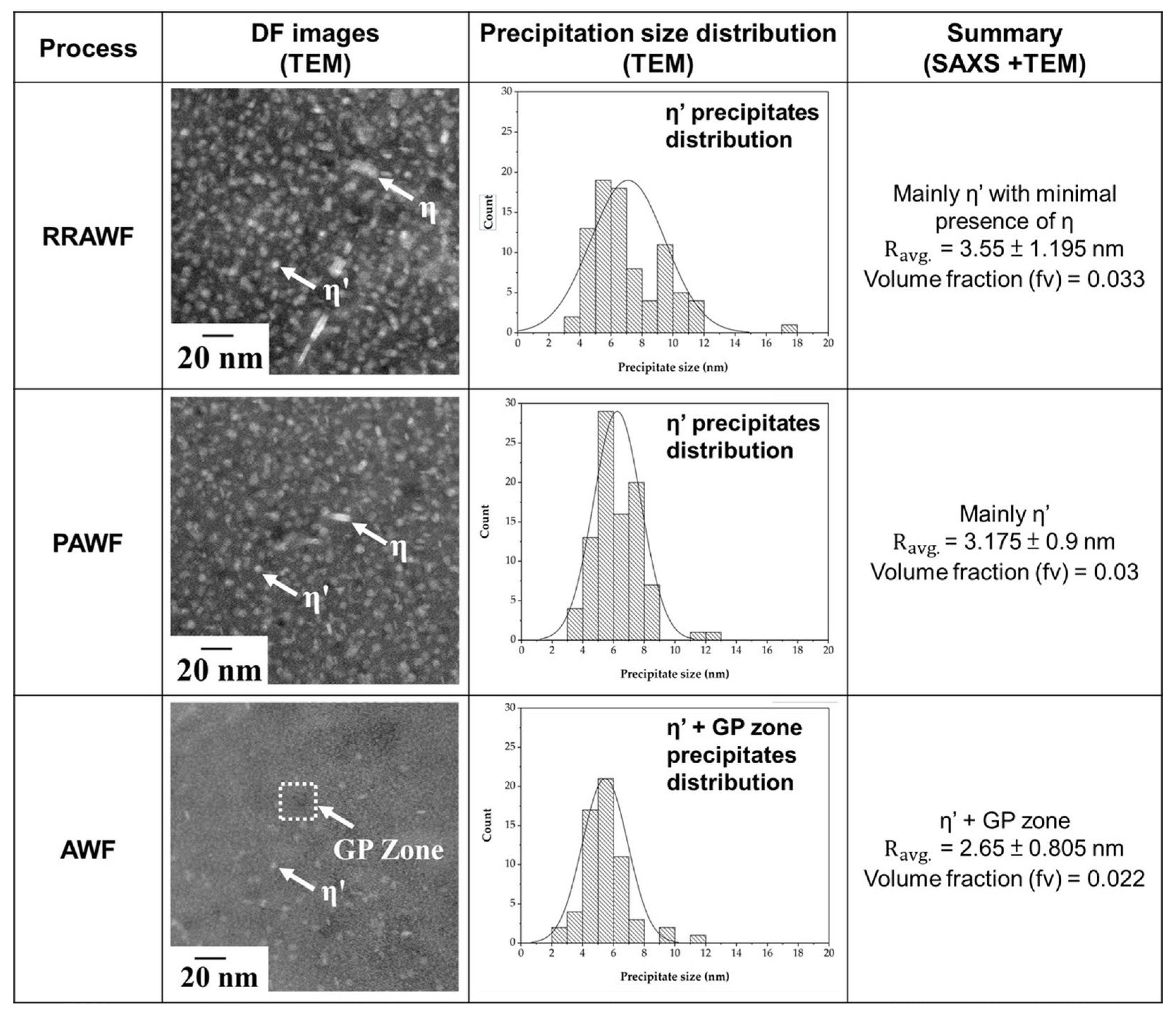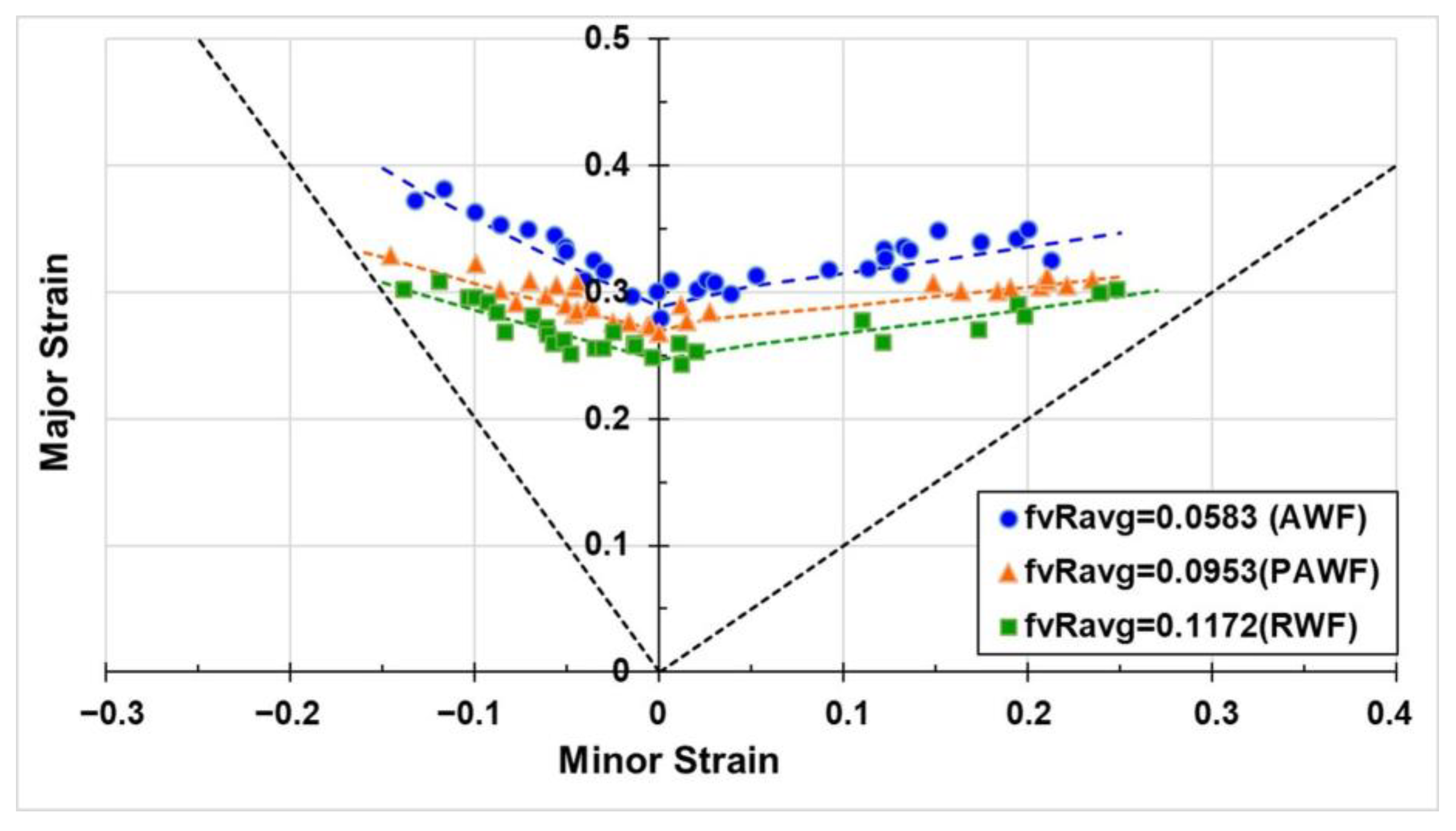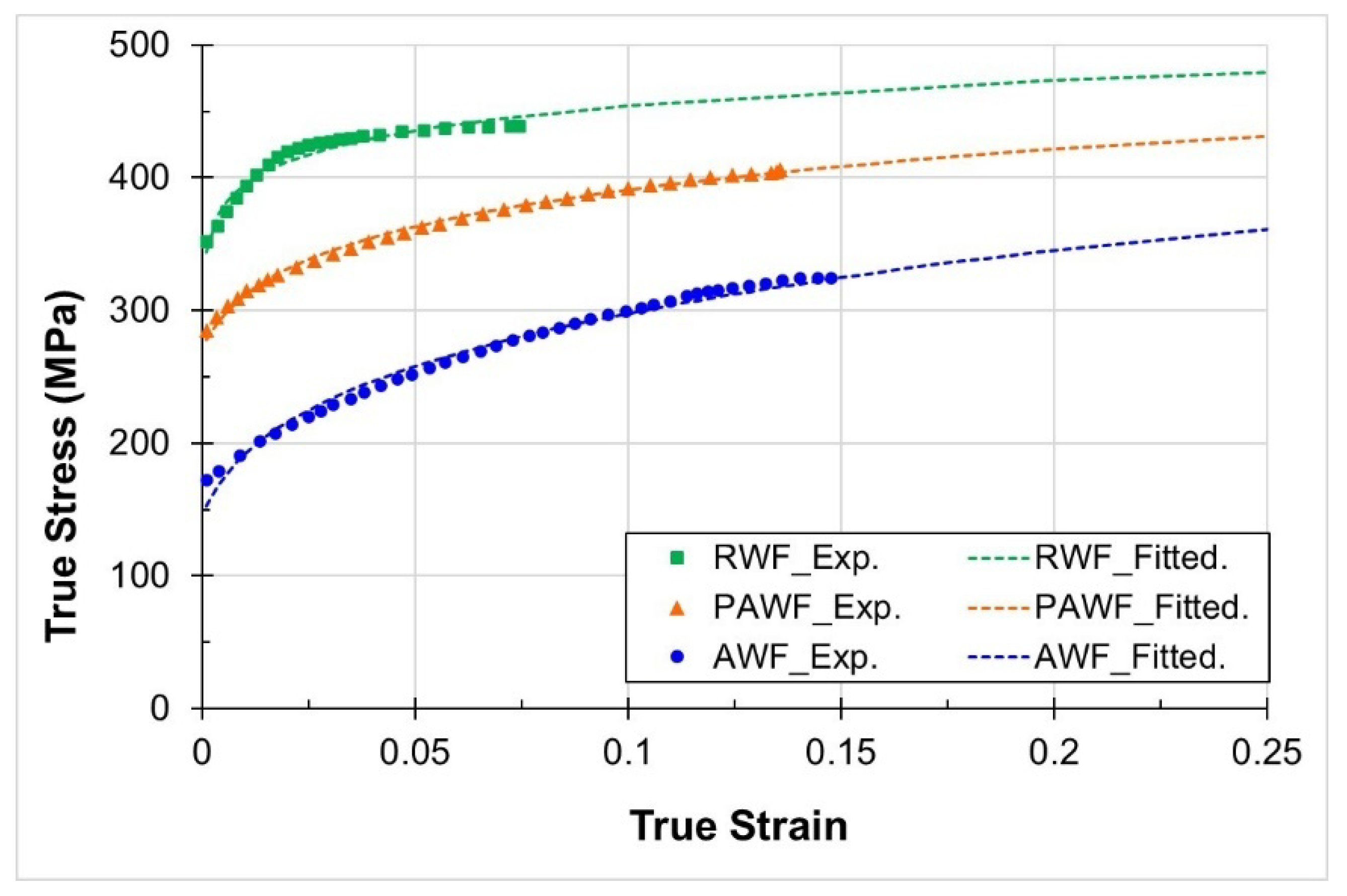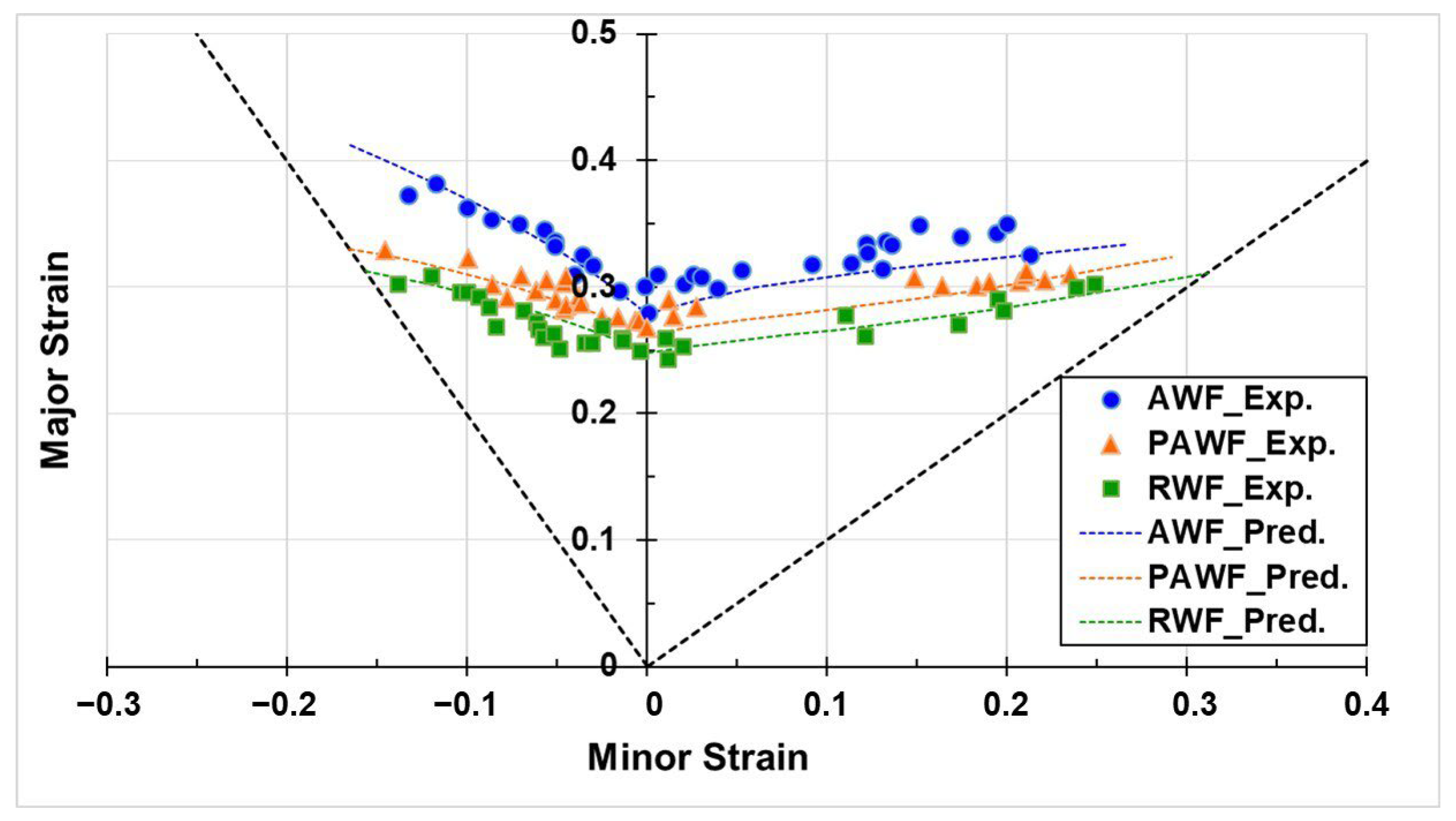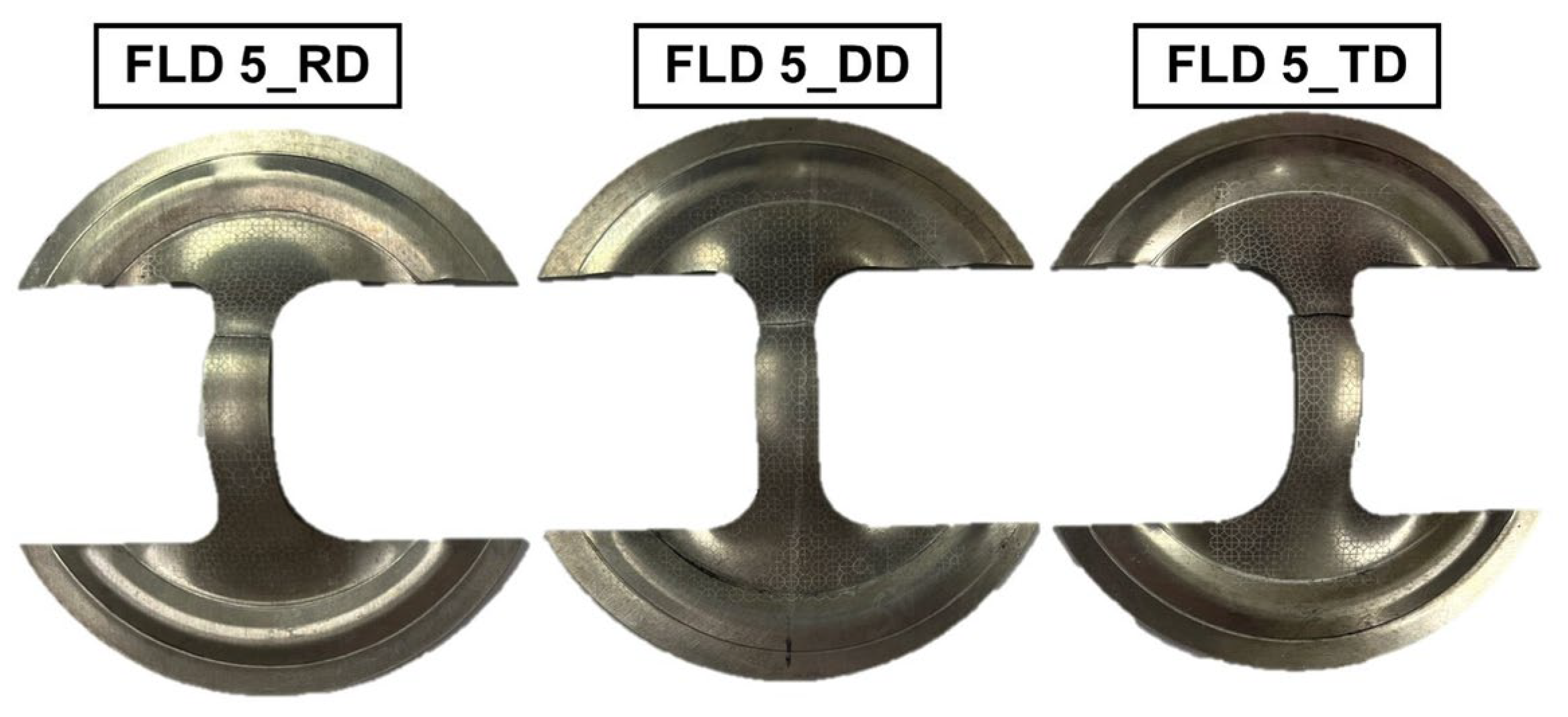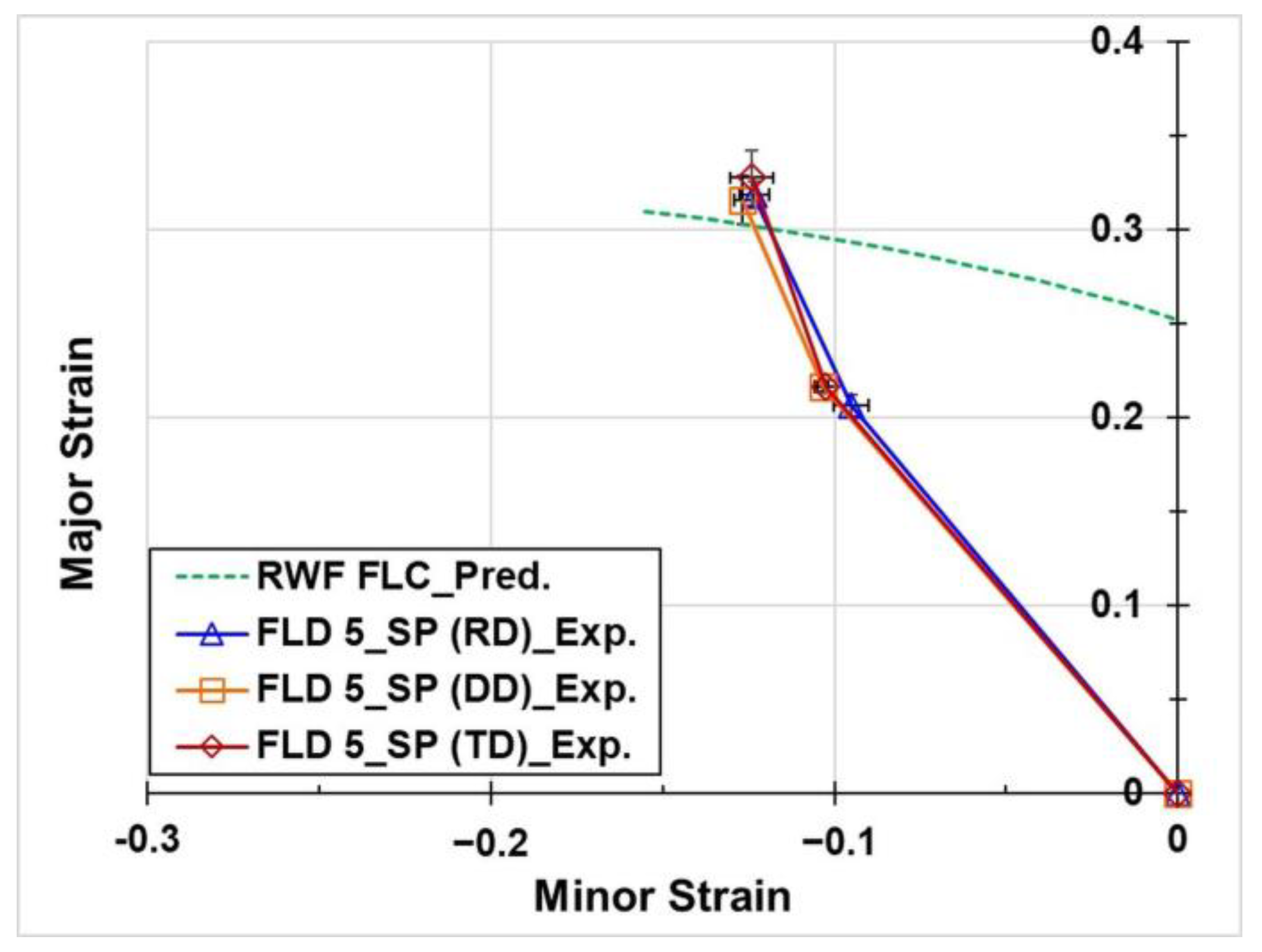1. Introduction
The AA7075 aluminium alloy, known for its high specific strength and excellent recyclability, is considered a promising lightweight material for carbon reduction efforts and has garnered increasing attention in the automotive industry for structural applications [
1]. However, its inherently limited formability at room temperature significantly restricts its broader adoption, particularly in the manufacturing of complex-shaped structural components. To address this limitation, various forming techniques have been developed to improve the formability of AA7075 alloys at elevated temperatures.
Warm forming of AA7075 alloy sheets within the temperature range of 180–250 °C has been demonstrated to significantly enhance formability, thereby supporting the feasibility of processing high-strength aluminium alloys under elevated temperature conditions [
2]. However, precipitate coarsening during forming, compounded by the subsequent paint-bake (PB) treatment, significantly degrades the material’s strength, thereby preventing the formed components from meeting the structural performance requirements specified by designers.
To address this issue, various warm forming strategies have been developed by integrating tailored pre-treatments, controlled forming temperatures, and carefully designed post-forming treatments to optimise the final mechanical performance. Ivanoff et al. [
3] examined the integration of retrogression and re-ageing (RRA) treatment into the warm forming process as a strategy to mitigate strength loss in AA7075-T6 warm-formed parts. With optimised forming parameters, the material demonstrated a twofold increase in ductility compared to cold forming, and the post-forming strength was successfully restored to levels comparable to the original T6 condition following PB treatment. Kumar et al. [
4] investigated the warm forming process parameters for AA 7xxx sheets subjected to various pre-ageing (PA) treatments, analysing the effects of different processing conditions on ductility and post PB mechanical properties. The results demonstrated that, under appropriate forming conditions, ductility was markedly enhanced, while the strength loss following PB treatment was limited to within 5% of the original T6 condition. Additionally, the study highlighted those variations in PA conditions, which alter the characteristics of matrix precipitates (MPts), significantly influence the warm ductility of Al–Zn–Mg–Cu aluminium alloy sheets. A novel warm forming process, referred to as ageing warm forming (AWF), was proposed in the authors’ previous study [
5]. In this process, W-tempered AA7075 sheets are heated to the target forming temperature and held to complete the initial stage of artificial ageing prior to deformation. The subsequent PB treatment enables the formed part to achieve approximately 93% of the T6 strength. Compared to retrogression warm forming (RWF) and pre-aged warm forming (PAWF), AWF significantly improves formability and work-hardening behaviour, primarily due to differences in matrix precipitate (MPt) characteristics.
The forming limit diagram (FLD), initially proposed by Keeler and Backofen and refined by Goodwin [
6], remains a standard tool for predicting fracture in sheet metal forming. Nakajima tests are widely employed to determine the critical strains required for constructing forming limit curves (FLCs) at room temperature (RT), and their applicability has since been extended to elevated temperature conditions. Feister et al. [
7] established the FLD for AA7075-T6 sheets through Nakajima tests conducted between RT and 220 °C. The resulting FLD was subsequently utilised in the forming analysis of side beams, demonstrating the accurate prediction of surface cracking when combined with bending failure considerations.
Determining FLCs requires extensive testing across multiple strain paths, making the process costly and time-consuming. This challenge becomes more critical at elevated temperatures, where predictive models are commonly employed to reduce experimental complexity. Among these, the Marciniak–Kuczynski (M–K) model [
8], which attributes fracture to diffuse necking, remains one of the most widely adopted approaches for predicting FLCs in aluminium alloy sheets under elevated temperatures. Chen et al. [
9] and Zhou et al. [
10] employed the M–K model, combined with various yield criteria and the Fields–Backofen equation, to predict the FLCs of AA5182 and AA2060 sheets under elevated temperatures and different strain rates. The model effectively captured the forming limits of aluminium sheets across these conditions. Although the M–K model remains effective, its predictive accuracy is highly sensitive to the calibration of initial geometric imperfections, which significantly impact FLC estimation and constitute a major limitation. Moreover, a previous study [
11] has shown that AA7075 sheets exhibit predominantly diffuse deformation with minimal localised necking under warm forming conditions at high strain rates (≥0.1 s
−1). As fractures can occur before the onset of visible necking, conventional necking-based models might lose predictive reliability. Therefore, ductile fracture criteria that incorporate stress state and damage accumulation are more suitable for failure prediction under such conditions.
The Cockcroft and Latham (C&L) criterion [
12] is a widely used model for predicting the ductile fracture strain limit of sheet metals and has demonstrated reasonable accuracy across various forming conditions. However, traditional C&L predictions often underestimate forming limits under biaxial tensile conditions (i.e., the first quadrant of the FLD) [
13]. To address this limitation, several modified versions of the C&L criterion have been developed, showing improved accuracy in predicting fracture strains. Atkins et al. [
14] modified the C&L criterion by incorporating strain path effects based on experimental observations, suggesting that strain path dependency should be considered when predicting forming limits in sheet metal forming. Zhuang [
15] developed a strain-path-dependent modification of the C&L criterion by introducing the strain ratio (ρ), enabling accurate predictions of FLCs across both the first and second quadrants for steel sheets of varying thicknesses, and highlighting the critical role of strain path sensitivity in energy-based ductile fracture criteria. Its reliability has been validated under various forming conditions, consistently demonstrating high accuracy in simulation-based applications. Building upon Zhuang’s framework, Lee et al. [
16] extended the modified C&L criterion to hot stamping conditions for 22MnB5 steel by integrating it into a Gleeble simulator-based experimental-numerical methodology. The study predicted FLCs at various heating temperatures (650 to 850 °C) using specimens designed to isolate different strain paths. Although the model did not explicitly incorporate temperature-dependent parameters, it implicitly captured thermal effects through microstructural and mechanical responses—such as the variation in strain path and matrix strength—as temperature altered the material’s deformation characteristics. These effects were reflected in the accumulated strain energy reaching the fracture threshold C, thus enabling accurate temperature-sensitive formability predictions without direct thermal terms. Efforts have also been made to enhance the C&L model by incorporating microstructural characteristics. Chen et al. [
17] modified the normalised C&L model using the thickness-to-grain-size (T/D) ratio to predict microscale sheet forming limits, achieving strong alignment with the experimental results. These developments underscore the effectiveness of incorporating strain path sensitivity and microstructural parameters into ductile fracture models for accurate FLC prediction under diverse forming conditions.
The incorporation of plastic flow models and fracture criteria into FE frameworks has become a widely adopted and effective strategy for predicting deformation and failure during process development and design. Wiesenmayer et al. [
18] developed a thermo-mechanically coupled FE model in LS-DYNA, incorporating the GISSMO criterion to simulate temperature-dependent fracture behaviour, successfully predicting joint geometry and fracture locations during the shear-clinching of 7xxx aluminium sheets subjected to localised heat treatment, while also capturing the effects of thermal softening on material flow. Grabner et al. [
19] employed LS-DYNA with a GISSMO model calibrated through tensile tests to simulate the warm forming of pre-aged 7xxx alloys, achieving accurate predictions of the deep drawing behaviour of AA7075 and AA7021+ at 120 °C and 160 °C, in strong alignment with the experimental data. Zhou et al. [
10] incorporated the M–K model into an FE framework to simulate the hot forming of AA2060 sheets, accurately predicting fracture locations, forming defects, and material deformation behaviour, thereby demonstrating its potential for the comprehensive prediction of material response under hot forming conditions.
The authors’ previous research [
5], along with existing studies, has shown that the MPts in AA7075 sheets affect both post-formed strength and deformation behaviour under warm forming conditions. However, their direct influence on formability remains insufficiently understood. Furthermore, FE models incorporating fracture criteria have been demonstrated to effectively predict the forming behaviour of sheet materials at elevated temperatures. In industrial applications, such models assist in identifying suitable warm forming conditions during the design phase by evaluating material deformation behaviour. Nevertheless, overly complex fracture modelling approaches may hinder practical implementation in industrial settings. Therefore, there is a critical need for fracture models that can be rapidly developed and can reliably predict material failure, enabling more efficient application in manufacturing environments. Accordingly, the warm formability of AA7075 sheets subjected to different heat treatments is investigated through warm isothermal Nakajima tests conducted under optimised process parameters identified in previous studies. In addition, critical MPts features influencing warm formability are identified by correlating microstructural characteristics with the warm forming limits determined in the present study. Based on the experimental results, a new model incorporating the MPt characteristics of AA7075 sheets is developed, based on the Zhuang criterion, to predict forming limits under various warm forming conditions. After validating its predictive accuracy through comparison with experimental results, the proposed model is integrated into the FE simulation of the RWF processing condition to develop a new approach for the rapid determination of the Lankford coefficient using isothermal Nakajima tests, thereby ensuring suitability for industrial applications.
